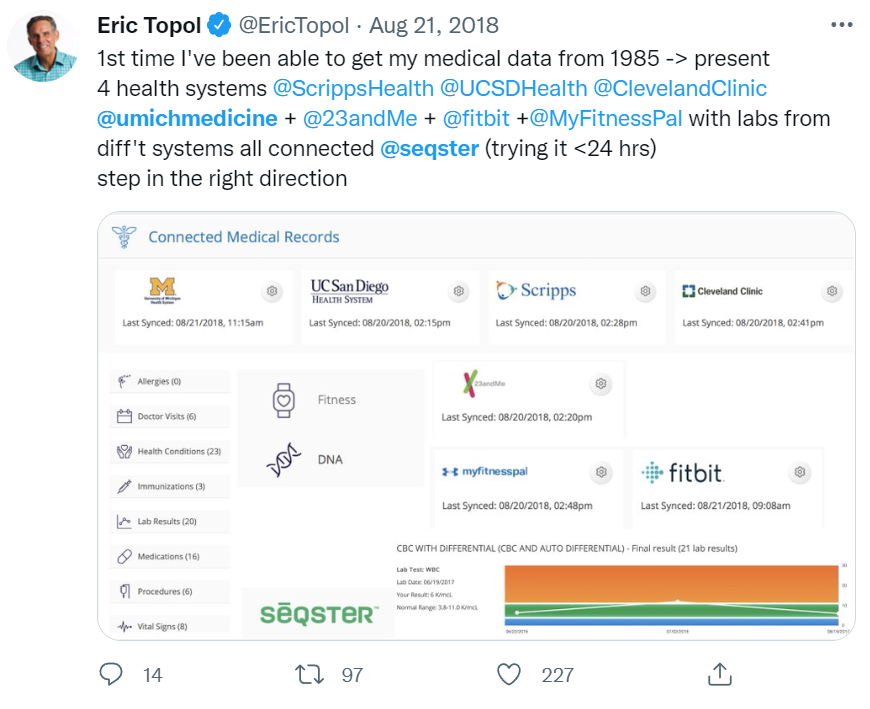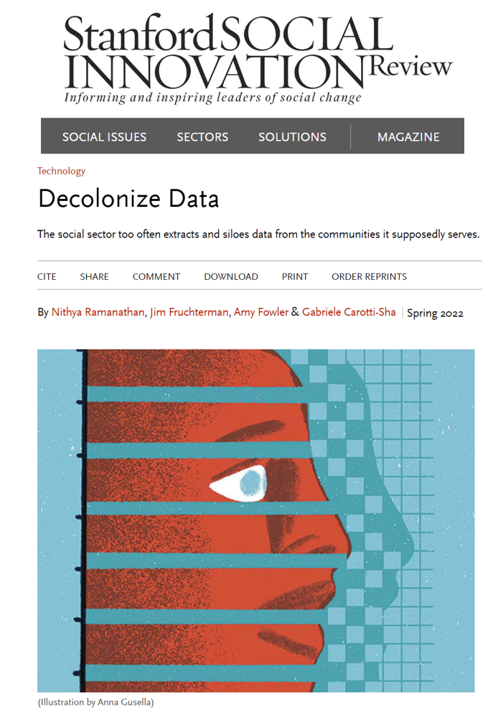He had me at the statement, “I believe health data is medicine.”
Those were the words of Ardy Arianpour, CEO and Co-Founder of Seqster, when sharing with me how his company was founded.
 We met up last week at the DIA Europe 2022 meeting (Drug Information Association) in the cool SQUARE Conference Center in Brussels, Belgium (my current home base for work and life). It was a rare opportunity to sit still with this on-the-go guy with whom an hour spent is the equivalent of three hours with most other folks.
We met up last week at the DIA Europe 2022 meeting (Drug Information Association) in the cool SQUARE Conference Center in Brussels, Belgium (my current home base for work and life). It was a rare opportunity to sit still with this on-the-go guy with whom an hour spent is the equivalent of three hours with most other folks.
Ardy and the team call Seqster “the operating system for health care,” a trademarked phrase.
Turbocharging, really inspiring that bold statement is the love of a son for his parents coupled with tech-innovation chops that could, indeed, eventually bring that audacious claim of being health care’s OS to fruition.
First, consider: the lack of interoperability between health data, resulting in silos, has plagued our ability to “operate” (that “O” in “OS”) in a smooth fashion across the care continuum, from clinical trials and research to patients’ self-care driving optimal outcomes.
Our desire for data liquidity has eluded us across the health/care ecosystem for too long, notwithstanding American taxpayers’ $35 bn investment in EHRs dating to the American Recovery and Reinvestment Act of 2009 that embedded the HITECH Act funding EHR adoption for hospitals and physician practices.
Second, add into the mix: Ardy’s parents are both cancer survivors and as he describes himself, he’s the “poster child” for family health issues. His personal DNA led him to his career journey and love of genetics.
 After successful stints working in genetics for nearly 20 years, Ardy co-founded Seqster with partners Xiang (Sean) Li and Dana Hosseini, fellow genomics veterans, and the trio hunkered down to de-fragment the incredibly fragmented, siloed health data ecosystem – emanating from big-iron closed EHRs to pharmacy claims, lab data, wearable devices, digital imaging, DNA/ancestry data, and remote patient monitoring devices.
After successful stints working in genetics for nearly 20 years, Ardy co-founded Seqster with partners Xiang (Sean) Li and Dana Hosseini, fellow genomics veterans, and the trio hunkered down to de-fragment the incredibly fragmented, siloed health data ecosystem – emanating from big-iron closed EHRs to pharmacy claims, lab data, wearable devices, digital imaging, DNA/ancestry data, and remote patient monitoring devices.
The team did the heads-down hard work building out the ability to grab the data from hither, thither, and yon in real-time, enabling researchers, providers, and diagnosticians to view a longitudinal health profile of a patient: a comprehensive, 360-degrees view of the whole person. That’s why Seqster calls this solution “patient-centric interoperability.”
 Now, let’s ponder one particular patient whose name is Eric Topol, MD. You should know him for his work leading Scripps Research Translational Institute along with his must-read books, The Patient Will See You Now, Deep medicine, and The Creative Destruction of Medicine. He also tweets his own comments on Twitter @EricTopol, which have become must-click insights into the COVID-19 pandemic from the inception of the public health crisis.
Now, let’s ponder one particular patient whose name is Eric Topol, MD. You should know him for his work leading Scripps Research Translational Institute along with his must-read books, The Patient Will See You Now, Deep medicine, and The Creative Destruction of Medicine. He also tweets his own comments on Twitter @EricTopol, which have become must-click insights into the COVID-19 pandemic from the inception of the public health crisis.
With that context, here’s some real-world evidence to consider: Dr. Topol’s experience with Seqster early in the company’s history led him to tweet the following on 21 August 2018, showing the actual tweet screenshot here:
“1st time I’ve been able to get my medical data from 1985>present 4 health systems @ScrippsHealth @UCSDHealth @ClevelandClinic @umichmedicine + @23andme + @fitbit + @MyFitnessPal with labs from diff’t systems all connected @seqster (trying it <254 hrs). step in the right direction”
CBS News 8 San Diego covered a caregiver and cancer patient’s experience with a live shot of their thick binder, containing CDs with medical images and data from these various provider institutions laying on top of a pile of letters and lab test results.
The basic (well, not-so-basic) operating system starts with the electronic health record (EHR), accessing data for the patient: allergies, conditions, immunizations, labs, meds, procedures, vitals, in real-time and in a continuous longitudinal timeline.

For wonky-tech readers, this involves using Seqster’s proprietary technology (FHIR+) to enable the flow of patient information from once-siloed data locked into legacy systems and wearable tech clouds.
Seqster’s March 14th press release, Seqster Launches Developer Portal Delivering Longitudinal Health Data and Patient Engagement Directly Into Life Science Enterprise Workflows, announced the company’s developer portal that automates patient data across their health journey — from pre-diagnosis, diagnosis and treatment, to study participation — as well as continuous long-term monitoring for outcomes research and ongoing observation.
This capability is attracting pharmaceutical and life science companies, health care providers and research organizations to take a closer look at Seqster’s offering.
UBC is among the organizations partnering with Seqster to enable patient engagement and interoperability. UBC is evolving from site-based clinical trial research to decentralized clinical trials (DCTs). This will enable UBC to modernize study designs, “capitalizing on patient mediated medical record release,” Aaron Berger, Executive Director, RWE, of UBC explained in the project’s press release. Aaron called this “a game-changer for our clients,” who are pharmaceutical, biotech and other life science innovators. Note that UBC’s tagline is “Patients first, powered by evidence.””
In summing up the patient-centered interoperability goal, Ardy summarized: “We’ve created the Mint.com of health data.”
Health Populi’s Hot Points: Many of my beloved and brilliant colleagues are convening this week at HealthDataPalooza and the National Health Policy Conference in Washington, DC.
They are brainstorming how to solve the challenges of health equity, interoperability, patient engagement, and digital literacy, among other barriers to making health care better for all health citizens. Among those informing discussions at the meeting are representatives from ONC, who will be discussing the latest 21st Century Cures Act interoperability and patient access guidelines — which Seqster embraces in their operating system.
 One quiet theme I teased out of the Twitter-conversation during the meeting is the concept of data colonialism — explained here in a just-published essay in the Stanford Social Innovation Review.
One quiet theme I teased out of the Twitter-conversation during the meeting is the concept of data colonialism — explained here in a just-published essay in the Stanford Social Innovation Review.
“All too often, social sector practitioners, including researchers, extract data from individuals…for their own purposes, and do not even make it available to them, let alone enable them to draw their own conclusions from it. With data flows the power to make informed decisions….If we are truly committed to decolonizing the practices in aid, then we must also examine the ownership and flow of data.”
From the SSIR explanation, I highlight key phrases for making health data flows more inclusive and impactful:
“Data is not a finite resource in the social impact sector, yet that is how we operate. We believe it is this reflexive tendency, rather than an insidious intent to keep communities down, that underpins data colonialism today. Sharing data would accelerate shared impact by aligning incentives and highlighting solutions that truly work. The sharing of aggregated and anonymized data sets can bring clarity to complex environments based on shared insights to work toward continuous improvement to existing systems.”
Seqster is working to solve this very barrier to peoples’ optimal health and, ultimately, their life expectancy as we are faced with tough diagnoses. Ardy and team did so for his father; one day, they may well do this for you or me. This is the promise of personalized medicine.





 Interviewed live on BNN Bloomberg (Canada) on the market for GLP-1 drugs for weight loss and their impact on both the health care system and consumer goods and services -- notably, food, nutrition, retail health, gyms, and other sectors.
Interviewed live on BNN Bloomberg (Canada) on the market for GLP-1 drugs for weight loss and their impact on both the health care system and consumer goods and services -- notably, food, nutrition, retail health, gyms, and other sectors. Thank you, Feedspot, for
Thank you, Feedspot, for  As you may know, I have been splitting work- and living-time between the U.S. and the E.U., most recently living in and working from Brussels. In the month of September 2024, I'll be splitting time between London and other parts of the U.K., and Italy where I'll be working with clients on consumer health, self-care and home care focused on food-as-medicine, digital health, business and scenario planning for the future...
As you may know, I have been splitting work- and living-time between the U.S. and the E.U., most recently living in and working from Brussels. In the month of September 2024, I'll be splitting time between London and other parts of the U.K., and Italy where I'll be working with clients on consumer health, self-care and home care focused on food-as-medicine, digital health, business and scenario planning for the future...